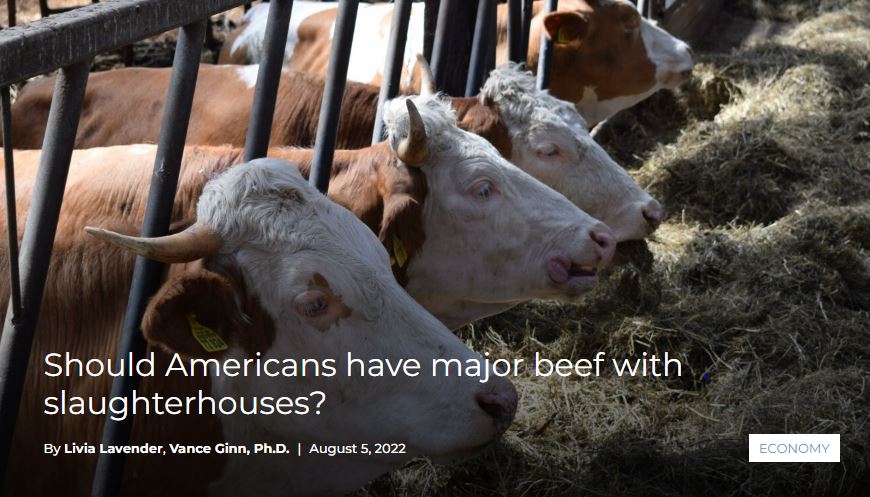|
Everyone is feeling the pinch at the supermarket these days, as inflation—measured by the decline in the purchasing power of money for a basket of goods and services—recently hit a 40-year high. From eggs to milk, it is getting harder to bring home the bacon. Nowhere has that been more visible than in the prices for beef.
While inflation has contributed to the increase in the price of beef, the scary truth is there is a more nefarious reason for this: excess regulation. The beef industry can be categorized into three sectors: cow-calf, stockyard, and slaughterhouse operations. Slaughterhouses have long been allowed to operate in what’s considered an oligopoly, as they’re heavily regulated by the United States Department of Agriculture (USDA) and Federal Drug Administration (FDA). A century ago, the Packers and Stockyards Act aimed to fix what was considered to be a market failure. It broke up the five major slaughterhouses controlling the beef industry. Yet today, only four slaughterhouses control 80% to 85% of America’s beef. Now, the Senate Agriculture Committee has passed two bills that aim to do that exact thing the Packers and Stockyards Act was supposed to do. That begs the obvious question: Is more regulation really the answer to this bloody mess? The proposed legislation of the Cattle Price Discovery and Transparency Act would require slaughterhouses to buy more cattle on the cash market. And the Meat and Poultry Special Investigator Act would require the USDA to investigate and prosecute anti-competitive practices. Cow-calf producers and stockyards are margin operators in one of the most complex markets in the world, and often fall victim to unpredictable forces like fluctuating demand, adverse weather, and disease. Of course, there are inherent risks in every market, and participants accept those risks. The issue here is these operators can appear to be unfairly squeezed by slaughterhouses that seem to be manipulating prices. These practices include utilizing market strategies such as forward contracting and retaining ownership. Forward contracting allows buyers and sellers to complete transactions months in advance to price in risk of the cash market. This strategy was intended to be a risk management tool for producers, giving them better control over their profit margins. Secondly, slaughterhouses have taken advantage of the “retained ownership” principle by purchasing their own stockyard inventory. Cattle in stockyards are typically owned outright by the yard or owned by cow-calf producers that retain ownership and pay on a per-head or per-day rate. So, in the event of unforeseen demand changes like, perhaps, a pandemic, inflation, drought, or mysterious cattle deaths, slaughterhouses can pull up their own inventory and mitigate any cost of buying cattle ready to be slaughtered at the cash market value. Put plainly, the new legislation would limit slaughterhouse’s ability to slaughter cattle they own in hopes of forcing them to offer producers higher prices. But this can only go so far. And likewise, there’s only so much regulation that can be implemented to correct issues created by overregulation. Threatening prosecution for market manipulation violations doesn’t break up the oligopolies because it addresses the wrong problem. Instead of trying to impose regulations to attempt to remedy the power disparity, eliminating the regulations that create barriers to entry in the first place would break up packer conglomerates naturally. In short, the answer to eliminating unfair pricing schemes does not lie in implementing additional regulations to an already heavily regulated industry. According to a 2022 report by the USDA, 900 slaughterhouses are federally inspected and 1,900 plants are not. The non-federally inspected plants that meet their states’ inspection standards can only sell or transport beef intrastate, barring them from being in direct competition with the Big Four. State inspections are required to meet criteria “at least equal to” federally inspected facilities. One solution is to add competition by deregulating the inspection requirements, which would result in more competitors for the slaughterhouses, helping achieve what as the two proposed bills aim to do through market forces instead of government regulation. Continued regulation of a market at this level is identical to how many experts believe India and many African countries fell into complete food dependence on their government. Congress’s signaled sympathy for cattlemen the past three years is probably all in vain—especially considering its legislation created the problem in the first place. Most importantly, consumers are about to feel even more pain at the meat counter come this fall. Without substantial deregulation of the beef industry, sly slaughterhouse owners and confused senators may enjoy their prime rib dinner, while the rest of us settle for chicken—or worse, “plant-based proteins.” Published at TPPF with Livia Lavender Comments are closed.
|
Vance Ginn, Ph.D.
|


 RSS Feed
RSS Feed